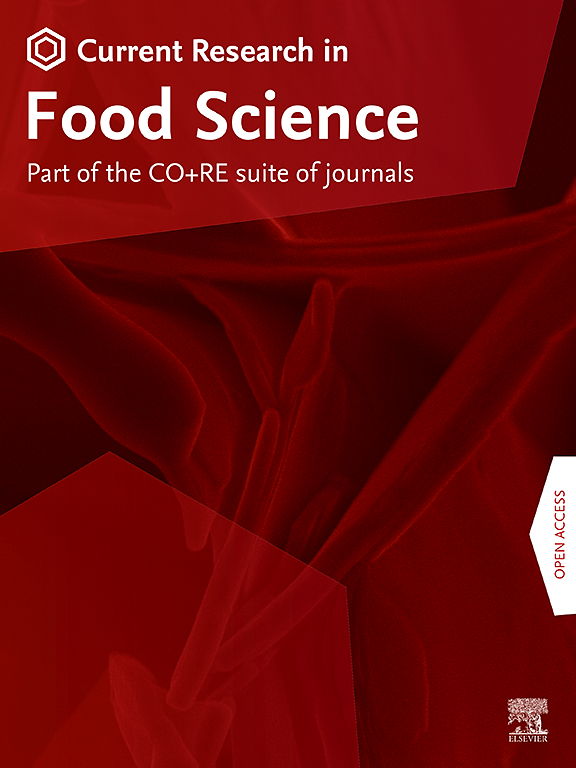Diversity of dietary protein patterns across Europe – Impact on nutritional quality and environmental sustainability
IF 6.2
2区 农林科学
Q1 FOOD SCIENCE & TECHNOLOGY
引用次数: 0
Abstract
Transitioning from animal-based to plant-rich diets could potentially improve both human and planetary health, but a thorough understanding of the protein component in the diet is essential. This research aimed to identify dietary protein patterns in the European adult population and evaluate differences in nutritional quality and environmental sustainability. Individual-level food consumption data were obtained from 25 European countries (40,101 participants, 18–64 years), available from the EFSA Comprehensive European Food Consumption Database. We applied statistical clustering to classify individuals according to their consumption of 24 protein source food groups. The patterns were evaluated for nutrient requirements, the Nutrient Rich Diet (NRD) 15.3 score, greenhouse gas emissions (GHGE) and land use (LU). Six patterns emerged: Common (42.2%), Fast-food (19.5%), Traditional (14.8%), Health-conscious (12.0%), Milk-rich (9.8%) and Plant-forward (1.6%), with country-specific variations. Most patterns obtained 64–69% of their protein intake from animal products, except for the Plant-forward pattern (52%). The Plant-forward pattern achieved the highest NRD15.3 (+11%), and lowest GHGE (−20%) and LU (−25%) compared to the population average and was most commonly consumed in Austria, Finland, Spain, Portugal and Belgium (4.1–4.5%). The Health-conscious pattern also scored high in nutritional quality (NRD15.3: +9%), whereas the Traditional pattern showed higher environmental impacts (GHGE: +5%, LU: +7%). These findings highlight the diversity of dietary protein patterns across Europe, each with unique nutritional profiles and varying environmental impacts. The Plant-forward pattern provides a promising example for healthier, more sustainable diets, but tailored approaches that consider the cultural and demographic contexts of individual countries are needed to optimize health and environmental outcomes for all patterns.

欧洲膳食蛋白质模式的多样性——对营养质量和环境可持续性的影响
从动物性饮食过渡到植物性饮食可能会改善人类和地球的健康,但对饮食中蛋白质成分的全面了解是至关重要的。这项研究旨在确定欧洲成年人的膳食蛋白质模式,并评估营养质量和环境可持续性的差异。个人层面的食品消费数据来自25个欧洲国家(40,101名参与者,18-64岁),可从欧洲食品安全局欧洲食品消费综合数据库获得。我们采用统计聚类方法对24种蛋白质源食物进行分类。采用养分需要量、营养丰富日粮(NRD) 15.3分、温室气体排放(GHGE)和土地利用(LU)评价模式。出现了六种模式:普通(42.2%)、快餐(19.5%)、传统(14.8%)、注重健康(12.0%)、富含牛奶(9.8%)和纯植物(1.6%),各国存在具体差异。大多数模式从动物产品中获得64-69%的蛋白质摄入量,除了植物向前模式(52%)。与人口平均水平相比,植物正向模式的NRD15.3(+11%)最高,GHGE(- 20%)和LU(- 25%)最低,最常见于奥地利、芬兰、西班牙、葡萄牙和比利时(4.1-4.5%)。健康意识模式的营养质量得分较高(NRD15.3: +9%),而传统模式的环境影响较高(GHGE: +5%, LU: +7%)。这些发现突出了欧洲各地饮食蛋白质模式的多样性,每种模式都有独特的营养概况和不同的环境影响。“向前种植植物”模式为更健康、更可持续的饮食提供了一个有希望的榜样,但需要考虑到各个国家的文化和人口背景的量身定制的方法,以优化所有模式的健康和环境结果。
本文章由计算机程序翻译,如有差异,请以英文原文为准。
求助全文
约1分钟内获得全文
求助全文
来源期刊

Current Research in Food Science
Agricultural and Biological Sciences-Food Science
CiteScore
7.40
自引率
3.20%
发文量
232
审稿时长
84 days
期刊介绍:
Current Research in Food Science is an international peer-reviewed journal dedicated to advancing the breadth of knowledge in the field of food science. It serves as a platform for publishing original research articles and short communications that encompass a wide array of topics, including food chemistry, physics, microbiology, nutrition, nutraceuticals, process and package engineering, materials science, food sustainability, and food security. By covering these diverse areas, the journal aims to provide a comprehensive source of the latest scientific findings and technological advancements that are shaping the future of the food industry. The journal's scope is designed to address the multidisciplinary nature of food science, reflecting its commitment to promoting innovation and ensuring the safety and quality of the food supply.
 求助内容:
求助内容: 应助结果提醒方式:
应助结果提醒方式:


